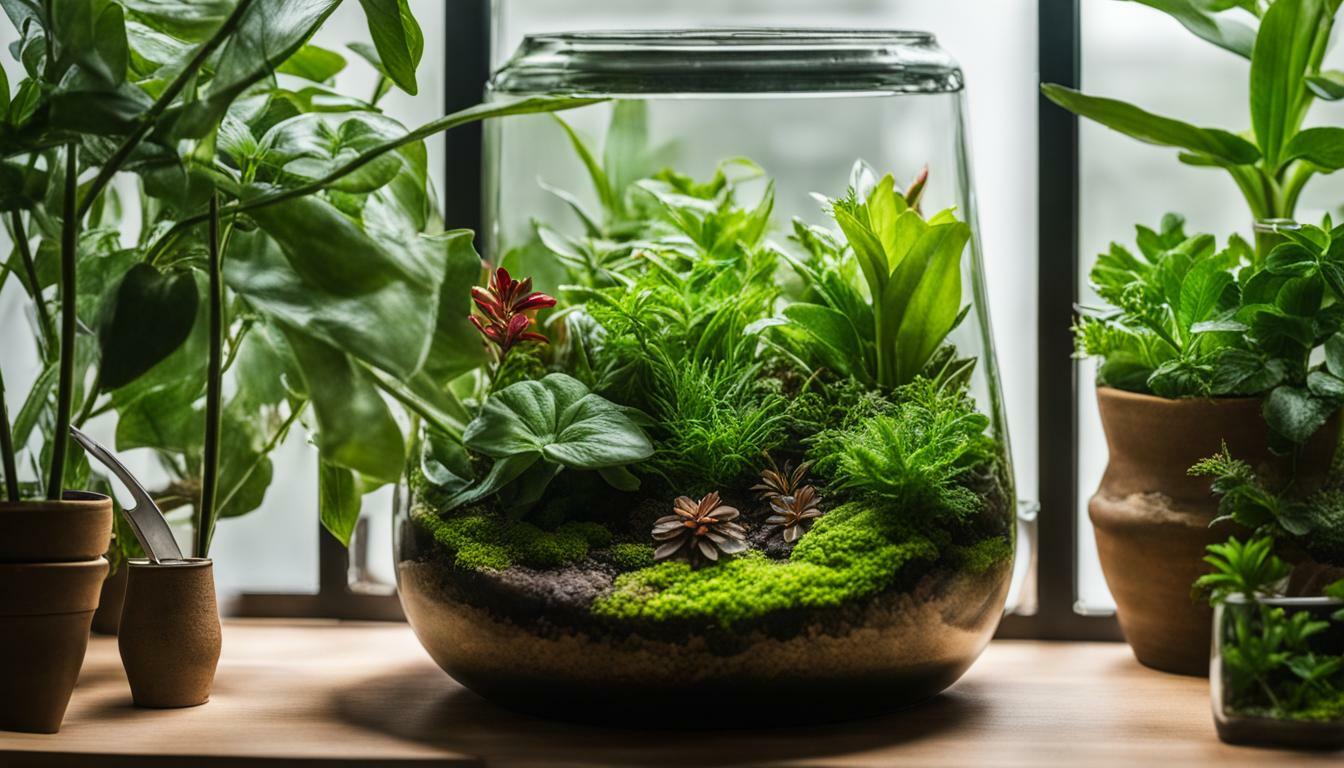Terrarium care and repair are essential for maintaining a thriving mini ecosystem in your home or office.
Creating and tending to a terrarium is a delightful way to bring the beauty of nature indoors. However, to ensure the long-lasting health and beauty of your terrarium, it is crucial to know the proper care and maintenance techniques.
First and foremost, avoid common mistakes that can harm your terrarium. Placing it in direct sunlight or near heat sources can cause damage to the delicate plants. Most terrarium plants thrive in indirect light, but if natural lighting is insufficient, consider using grow lights to provide the necessary illumination.
Pruning and trimming your terrarium plants is another important aspect of their care. Regularly removing any overcrowded or diseased plants not only improves aesthetics but also prevents the spread of problems to other plants. Maintain a clean and healthy environment by cleaning the glass of your terrarium regularly. Use a damp cloth or newsprint to gently wipe away any dirt or grime, avoiding harsh cleaning products that can harm the plants.
Proper watering techniques are crucial for the well-being of your terrarium. Closed terrariums create their own self-watering system through condensation, while open terrariums require weekly watering, especially for succulents and cacti. It is essential to strike a balance between providing enough moisture without overwatering, which can lead to root rot.
If you notice any signs of illness or mold growth in your terrarium plants, take immediate action. Adjust the light exposure or humidity levels as needed, and promptly remove any dead or moldy parts to prevent further spread of issues. Regular maintenance and attention to these details will ensure the long-lasting beauty and health of your terrarium.
Key Takeaways:
- Proper care is essential for maintaining a healthy terrarium ecosystem.
- Avoid placing your terrarium in direct sunlight or near heat sources.
- Indirect light or grow lights are ideal for terrarium plants.
- Regular pruning and trimming prevent overcrowding and the spread of diseases.
- Clean the terrarium glass gently with a damp cloth or newsprint.
The Basics of Terrarium Care
To ensure the longevity of your terrarium, it’s crucial to master the basics of terrarium care. Making and maintaining a terrarium is a great way to bring natural elements into your home or office, but it requires proper attention and care.
One of the most common mistakes in terrarium care is placing the terrarium in direct sunlight or near heat sources. This can lead to damage and even death of the plants. Most terrarium plants thrive in indirect light, so it’s important to find a suitable location away from direct sunlight. However, if you don’t have access to sufficient natural light, consider using grow lights to supplement the lighting needs of your terrarium.
Pruning and trimming are essential practices for proper terrarium maintenance. Regularly pruning and trimming the plants helps prevent overcrowding and the spread of diseases. It’s important to remove any diseased or dying plants promptly to prevent further issues.
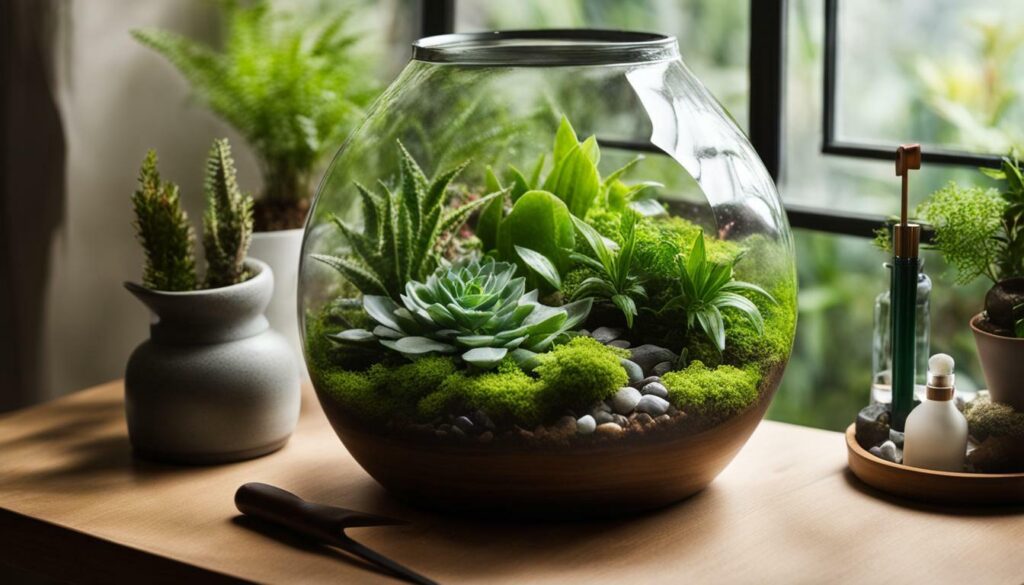
Cleaning the glass of your terrarium is crucial for optimal light transmission. Dust and dirt can accumulate on the glass, blocking the light from reaching the plants. To clean the glass, use a damp cloth or newsprint, as harsh cleaning products can be harmful to the plants.
Watering is another important aspect of terrarium care. Closed terrariums create their own self-watering system through condensation, so you don’t need to water them as frequently. On the other hand, open terrariums require regular watering, usually once a week for succulents and cacti. It’s important to monitor the moisture levels of your terrarium and adjust the watering frequency accordingly.
Summary:
- Avoid placing your terrarium in direct sunlight or near heat sources.
- Consider using grow lights if natural lighting is insufficient.
- Prune and trim your terrarium plants to prevent overcrowding and remove diseased or dying plants.
- Clean the glass of your terrarium regularly to ensure optimal light transmission.
- Follow proper watering techniques based on the type of terrarium you have.
By mastering these basics of terrarium care, you can enjoy the beauty of your mini ecosystem for years to come.
Terrarium Lighting Tips
Proper lighting plays a vital role in the health and growth of terrarium plants. When creating a terrarium, it’s essential to understand the lighting requirements of the plants you choose. Most terrarium plants thrive in indirect light, so it’s important to avoid placing your terrarium in direct sunlight or near heat sources, as this can result in damage to the plants.
If natural light is insufficient for your terrarium, consider using grow lights. These artificial light sources provide the necessary wavelengths for photosynthesis, ensuring optimal plant growth. When using grow lights, position them at an appropriate distance above the terrarium to prevent overheating or burning of the plants. Be sure to follow the manufacturer’s instructions for the specific type of grow light you have.
To troubleshoot lighting-related issues in your terrarium, carefully observe your plants. If you notice signs of light deficiency, such as yellowing leaves or stunted growth, consider increasing the intensity or duration of light exposure. Conversely, if you observe signs of light excess, such as scorched or wilted leaves, adjust the distance between the light source and the terrarium to reduce the intensity of light.
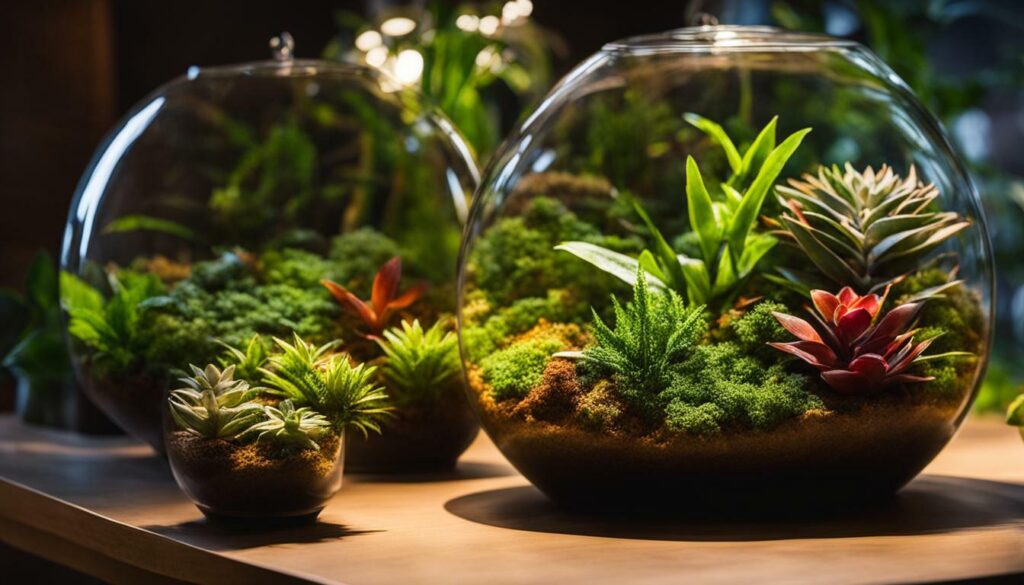
Remember, every terrarium is unique, and the lighting requirements may vary depending on factors such as the type of plants and the size of your terrarium. Regularly monitor your plants and make adjustments as necessary to ensure they receive the appropriate amount of light for their growth and well-being.
Pruning and Trimming Techniques
Pruning and trimming are essential skills for maintaining a well-balanced and healthy terrarium. These practices help prevent overcrowding and the spread of diseases, ensuring that your mini ecosystem thrives. To keep your terrarium in tip-top shape, follow these simple techniques:
- Identify problem areas: Regularly inspect your terrarium for plants that are overcrowding or showing signs of disease. Look for yellowing leaves, wilting, or mold growth. By identifying these problem areas, you can take targeted actions to maintain the overall health of your terrarium.
- Prune with precision: Use a clean pair of scissors or pruning shears to trim away any diseased or dying plant material. Make clean cuts just above a healthy leaf or node to promote new growth. Be sure to remove any fallen leaves or debris from the terrarium to prevent rot and pests.
- Create a balanced composition: As you prune and trim, consider the overall composition of your terrarium. Aim for a balanced arrangement by removing excess growth and ensuring that each plant has enough space to flourish. This will not only improve the visual appeal of your terrarium but also promote healthier plant growth.
Pruning Example:
“Pruning is an art form that allows you to shape and guide the growth of your terrarium plants. By removing excess foliage, you create a harmonious environment where each plant can thrive. Just like a well-groomed bonsai, a pruned terrarium becomes a living work of art.”
Remember, each terrarium is unique, and the specific pruning and trimming needs may vary depending on the plants you have chosen. Taking the time to understand their individual requirements will help you maintain a lush and vibrant terrarium.
| Key Points | Details |
|---|---|
| Tools needed | Scissors or pruning shears |
| Trimming frequency | Regularly inspect and trim as needed |
| Trimming technique | Clean cuts just above a healthy leaf or node |
| Benefits of pruning | Prevents overcrowding, promotes new growth, improves visual appeal |
By incorporating regular pruning and trimming into your terrarium maintenance routine, you can ensure that your miniature garden remains healthy and visually stunning. The careful attention you give to these techniques will pay off in the long run, allowing you to enjoy the beauty and serenity of your terrarium for years to come.
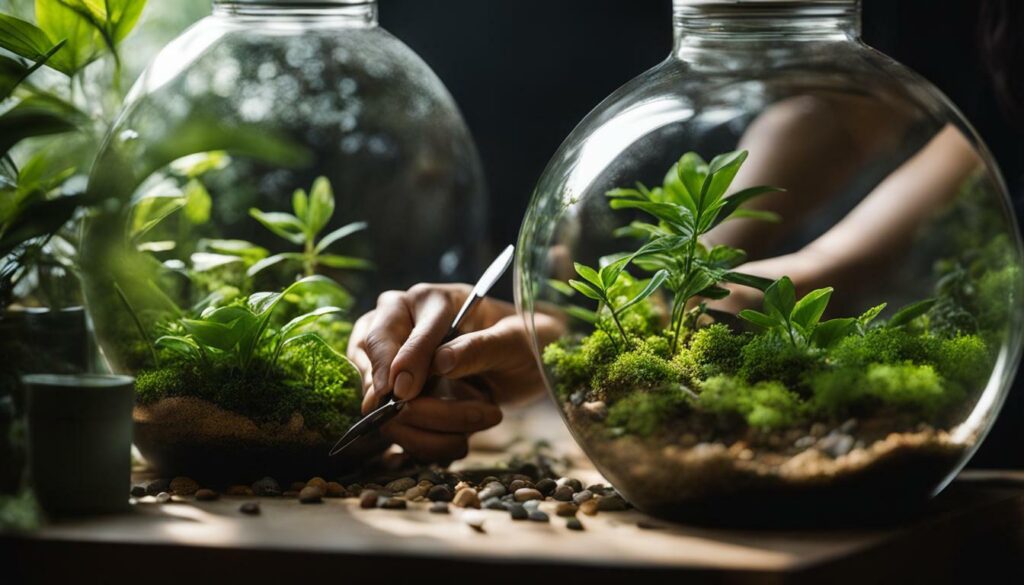
Regular glass cleaning is necessary to maintain the clarity and beauty of your terrarium. The glass walls provide the perfect showcase for your mini ecosystem, allowing you to fully appreciate the vibrant colors and intricate details of the plants inside. To keep your terrarium looking its best, follow these glass cleaning tips:
- Use non-abrasive materials: When cleaning the glass, avoid using abrasive materials that can scratch or damage the surface. Instead, opt for a soft cloth or even newsprint, which can effectively remove dirt and grime without leaving behind any scratches.
- Choose gentle cleaning agents: Harsh cleaning products can be harmful to the plants inside your terrarium. Stick to mild, eco-friendly cleaners or simply use a mixture of water and mild dish soap. Apply the cleaning solution to the cloth or paper and gently wipe the glass in circular motions.
- Mind the corners and edges: Pay special attention to the corners and edges of the glass, as these areas tend to accumulate more dust and debris. Use a cotton swab or a soft-bristled toothbrush to reach these tight spots and ensure a thorough clean.
Regular glass cleaning not only enhances the visual appeal of your terrarium, but it also allows maximum light transmission to the plants. By following these simple tips, you can maintain the clarity and beauty of your terrarium, creating an optimal environment for the plants to thrive.
Table: Recommended Cleaning Products for Terrarium Glass
| Product | Key Features |
|---|---|
| ECOS Glass + Surface Cleaner | Non-toxic, ammonia-free formula |
| Method Glass + Surface Cleaner | Plant-based, streak-free formula |
| Simple Green Naturals Glass Cleaner | Non-toxic, biodegradable formula |
Choose one of these recommended cleaning products to ensure the safety of your terrarium plants while effectively removing dirt and maintaining the clarity of the glass.
“Regular glass cleaning not only enhances the visual appeal of your terrarium, but it also allows maximum light transmission to the plants.”
A clean glass surface is essential for the health and overall aesthetic of your terrarium. Make glass cleaning a part of your regular maintenance routine to keep your terrarium looking its best and to provide an optimal environment for your plants to flourish.
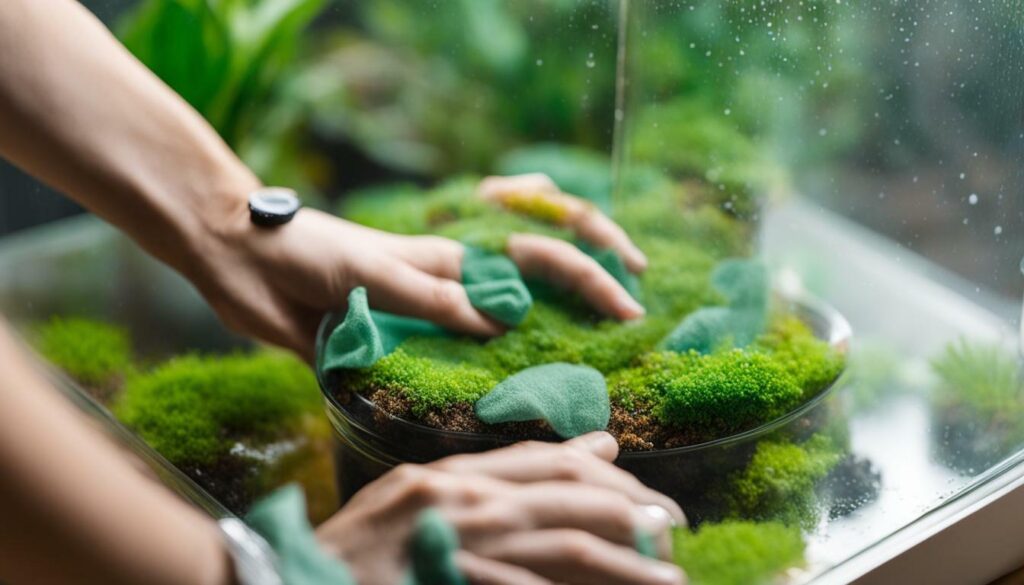
Proper watering is key to maintaining a thriving terrarium environment. The watering needs of terrariums can vary depending on whether they are closed or open. Closed terrariums provide a self-sustaining system with condensation that drips back into the soil, creating a mini water cycle. Open terrariums, on the other hand, require manual watering to ensure the right moisture levels for the plants.
For closed terrariums, monitor the condensation inside the glass. If there is excessive condensation or the soil feels overly wet, remove the lid for a short time to allow excess moisture to evaporate. On the other hand, if there is little to no condensation, add a small amount of water to the soil. It’s important to strike a balance to prevent the growth of mold or the saturation of the soil.
Open terrariums with succulents and cacti need less frequent watering. These plants are adapted to arid conditions and prefer well-draining soil. Water them once a week or when the soil feels dry to the touch. Be cautious not to overwater, as this can lead to root rot and other issues.
| Type of Terrarium | Watering Frequency |
|---|---|
| Closed Terrarium | Monitor condensation levels, add water if necessary |
| Open Terrarium with Succulents and Cacti | Water once a week or when soil feels dry |
Tips for Watering Terrariums
- Use a watering can with a narrow spout or a spray bottle to control the amount of water you provide.
- Avoid getting water on the leaves of plants, as this can promote the growth of mold and other plant diseases.
- Don’t let water collect in the bottom of the terrarium. Ensure proper drainage by using a layer of rocks or activated charcoal at the bottom.
- Pay attention to the specific water requirements of the plants in your terrarium. Some plants may need more or less water than others.
“Proper watering is fundamental for the health and longevity of your terrarium.”
By following these watering techniques and paying close attention to the specific needs of your terrarium, you can create an optimal growing environment for your plants. Remember, it’s always better to underwater than to overwater, as most terrarium plants prefer drier conditions. With proper care and attention, your terrarium will flourish and bring a touch of nature into your indoor space.
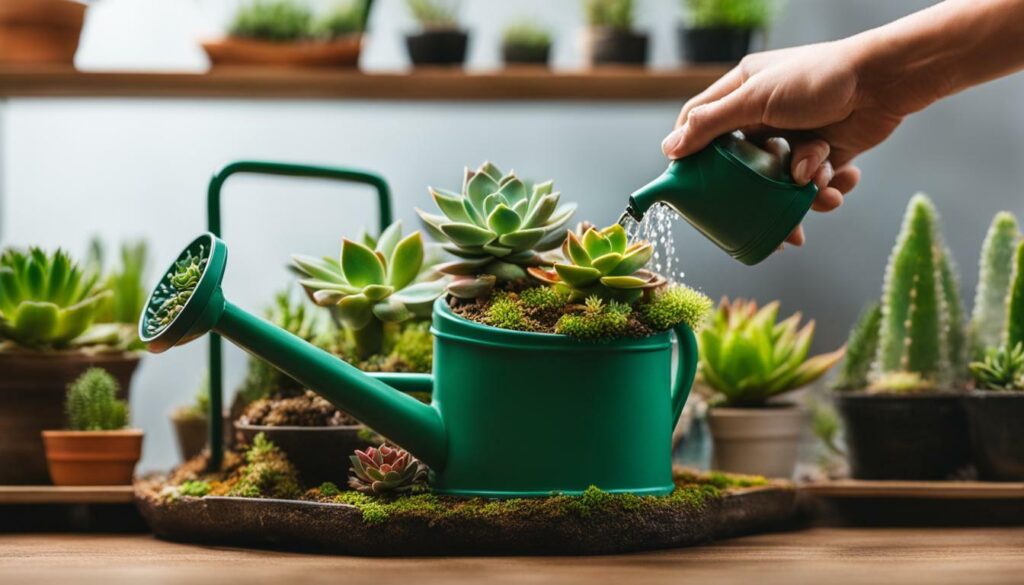
Troubleshooting Common Terrarium Issues
Identifying and addressing common terrarium issues is essential for the overall health of your mini ecosystem. By paying attention to potential problems and taking necessary actions, you can ensure that your terrarium thrives and remains a beautiful addition to your space. Here are some common issues that terrarium owners may encounter, along with practical solutions:
Mold Growth
Mold growth in a terrarium is a common problem that can be caused by excessive moisture and poor ventilation. To address this issue, remove any affected plants, as they may be contributing to the mold’s growth. Increase airflow by opening the terrarium for a few hours each day to promote better ventilation. Additionally, you can use a small fan to improve air circulation within the terrarium. Remember to monitor the humidity levels to prevent future mold growth.
Sickly Plants
If you notice that some of your terrarium plants are looking sickly, it’s important to take action promptly. Check for signs of pests, such as aphids or spider mites, and remove any affected plants to prevent the infestation from spreading. Adjusting the lighting conditions and humidity levels can also help revive sickly plants. If the problem persists, consider replacing the soil or changing the location of the terrarium to provide more suitable conditions for the plants.
Imbalanced Humidity
Humidity plays a vital role in the health of your terrarium. Too much or too little humidity can cause problems for the plants. To address imbalanced humidity levels, you can use a hygrometer to monitor the moisture content in the terrarium. If the humidity is too high, open the terrarium for some time to allow excess moisture to escape. Conversely, if the humidity is too low, mist the terrarium with water or place a shallow dish of water inside to increase moisture levels. Finding the right balance of humidity is crucial for the well-being of your terrarium plants.
| Common Issue | Solution |
|---|---|
| Mold Growth | – Remove affected plants – Increase ventilation – Monitor humidity levels |
| Sickly Plants | – Check for pests – Adjust lighting and humidity – Consider soil replacement or location change |
| Imbalanced Humidity | – Use a hygrometer to monitor humidity – Open terrarium to release excess moisture – Mist or add a shallow dish of water to increase humidity |
By addressing these common terrarium issues promptly and providing the necessary care, you can enjoy a thriving and visually appealing mini ecosystem in your home or office. Remember to regularly monitor the health of your terrarium and make adjustments as needed to maintain its long-term beauty and well-being.
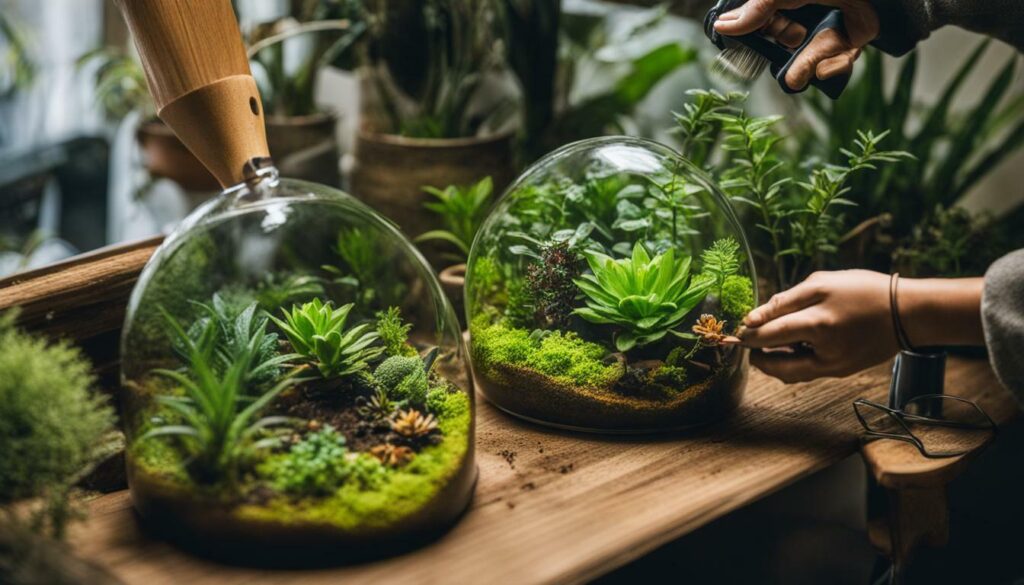
Ongoing maintenance is crucial for maintaining the health and vitality of your terrarium. Making and maintaining a terrarium is a great way to bring natural elements into your home or office. However, there are key considerations for proper care.
First and foremost, avoid common mistakes like placing the terrarium in direct sunlight or near heat sources, which can damage the plants. Most terrarium plants need indirect light, but if lighting is insufficient, consider using grow lights. It’s important to prune and trim plants to prevent overcrowding and remove diseased or dying plants that can spread problems to others.
Regularly cleaning the glass of the terrarium is necessary for light to reach the plants. Use a damp cloth or newsprint and avoid harsh cleaning products. When it comes to watering, closed terrariums create their own self-watering system with condensation, while open terrariums need weekly watering for succulents and cacti. Finally, if plants appear sick, address the issue by adjusting light exposure or humidity levels and removing any dead or moldy parts.
“A well-maintained terrarium not only enhances the aesthetic appeal of your space but also provides a healthy environment for the plants.”
Overall, proper care and attention will ensure the long-lasting beauty and health of your terrarium. Regular maintenance, including pruning, cleaning, and watering, is essential to create a thriving mini ecosystem. By following these simple maintenance guidelines, you can enjoy the benefits of a vibrant and captivating terrarium in your home or office.
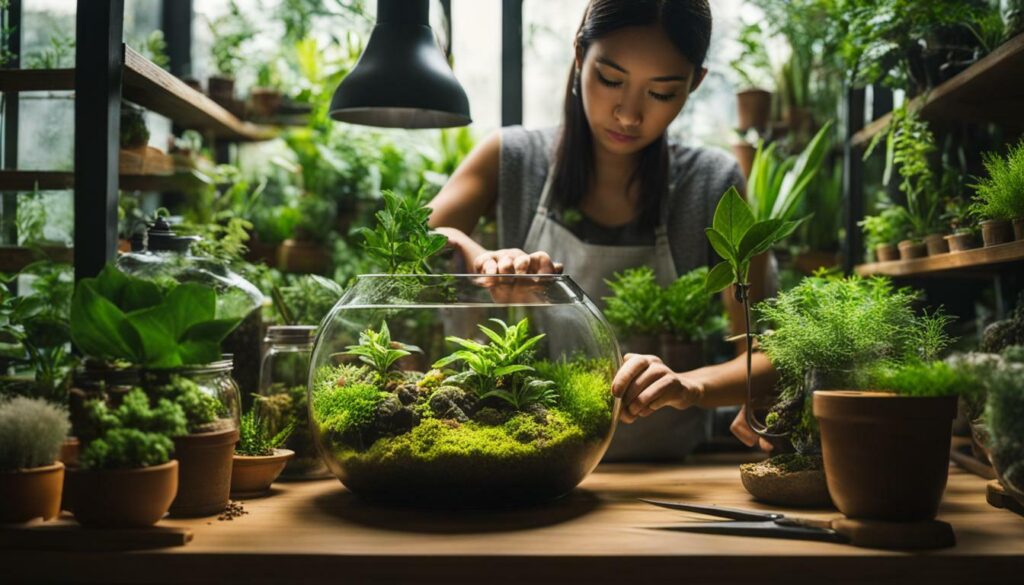
| Terrarium Care Tips | Terrarium Troubleshooting |
|---|---|
|
|
Enhancing Terrarium Design and Aesthetics
Elevate the visual appeal of your terrarium by incorporating design elements that complement your personal style. Adding decorative elements can transform your terrarium into a stunning centerpiece that captures attention and brings nature indoors.
Start by carefully selecting terrarium plants that not only thrive in the environment you’ve created but also add a pop of color and texture. Consider using a variety of plants with different shapes, sizes, and leaf patterns to create visual interest. Succulents and air plants are popular choices due to their unique forms and low maintenance requirements.
To further enhance the aesthetics of your terrarium, add decorative elements such as rocks, pebbles, moss, or driftwood. These natural elements not only create a visually pleasing composition but also provide a more realistic habitat for your plants. Experiment with different arrangements and textures to find the perfect balance.
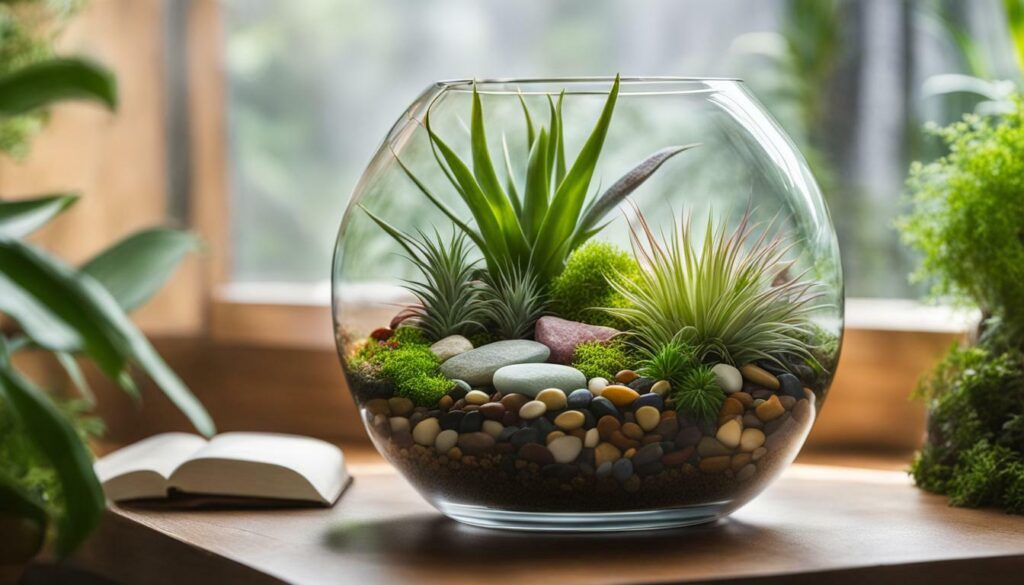
Another way to elevate the design of your terrarium is by choosing the right container. Opt for glass containers that allow for maximum visibility of the plants and their intricate details. You can also consider unique or vintage containers that add a touch of character and charm.
Don’t forget about the overall placement of your terrarium. Display it in an area that receives indirect natural light, such as a coffee table, sideboard, or windowsill. This will not only help the plants thrive but also create an inviting focal point in your space.
By incorporating these design elements and careful plant selection, you can create a visually stunning terrarium that not only enhances your living or workspace but also brings the beauty of nature indoors.
What Are Common Terrarium Issues and How Can They Be Fixed?
When it comes to maintaining a terrarium, issues may arise despite your terrarium care troubleshooting mastery. Common problems such as mold growth, overwatering, or yellowing plants can be easily fixed. Keep the terrarium clean, water sparingly, and ensure proper light and ventilation for thriving plants.
Conclusion
By mastering the art of terrarium care and repair, you can create a beautiful and thriving mini ecosystem in your home or office. Making and maintaining a terrarium is a great way to bring natural elements into your living or working space. However, it is essential to adhere to proper care techniques to ensure the health and longevity of your terrarium.
To begin with, avoid common mistakes that can harm your terrarium. Placing it in direct sunlight or near heat sources can damage the delicate plants inside. Most terrarium plants require indirect light, so if natural lighting is insufficient, consider using grow lights to supplement their needs. Proper lighting is crucial for the photosynthesis process and overall plant growth.
Pruning and trimming are vital practices for maintaining a healthy terrarium. Overcrowding can hinder the growth and development of plants, while diseased or dying plants can spread problems to others. Regularly inspect your terrarium and remove any undesirable foliage. Remember to use proper techniques and tools to ensure neat and precise trimming.
Cleaning the glass of your terrarium is another important aspect of care. Over time, dirt and grime can accumulate on the glass, preventing light from reaching the plants. To clean the glass, use a damp cloth or newsprint and avoid harsh cleaning products that may damage the glass or harm the plants. Keeping the glass clean will allow for optimal light transmission and a visually appealing display.
Proper watering is essential for the well-being of your terrarium. Closed terrariums create their own self-watering system through condensation, while open terrariums require weekly watering for plants like succulents and cacti. Avoid overwatering, as it can lead to root rot and other issues. Monitor the moisture levels and adjust your watering frequency accordingly.
If you encounter any issues with your terrarium, such as sickly plants or mold growth, troubleshoot the problem promptly. Adjusting light exposure or humidity levels can often help revive struggling plants. Additionally, removing any dead or moldy parts is crucial to prevent the spread of problems and maintain the overall health of your terrarium.
By following these care guidelines and paying attention to the needs of your terrarium, you can create a stunning and thriving mini ecosystem that brings a touch of nature into your surroundings. Enjoy the rewarding experience of caring for your terrarium and witnessing its beauty flourish over time.
FAQ
What are some common mistakes to avoid when caring for a terrarium?
One common mistake is placing the terrarium in direct sunlight or near heat sources, which can damage the plants. It’s important to provide indirect light and avoid extreme temperatures.
How should I prune and trim the plants in my terrarium?
To prevent overcrowding and the spread of diseases, it’s important to regularly prune and trim the plants in your terrarium. Use clean, sharp scissors or shears to remove dead or diseased foliage.
How do I clean the glass of my terrarium?
Cleaning the glass of your terrarium is essential to allow light to reach the plants. Use a damp cloth or newsprint to gently wipe away dirt and grime. Avoid using harsh cleaning products that can harm the plants.
How should I water my terrarium?
Closed terrariums create their own self-watering system through condensation, so no additional watering is necessary. For open terrariums with succulents or cacti, water them lightly once a week, allowing the soil to dry out between waterings.
What should I do if my terrarium plants appear sick?
If your terrarium plants appear sick, it’s important to address the issue promptly. Adjust the light exposure or humidity levels to create optimal conditions for the plants. Also, remove any dead or moldy parts to prevent the spread of problems.

